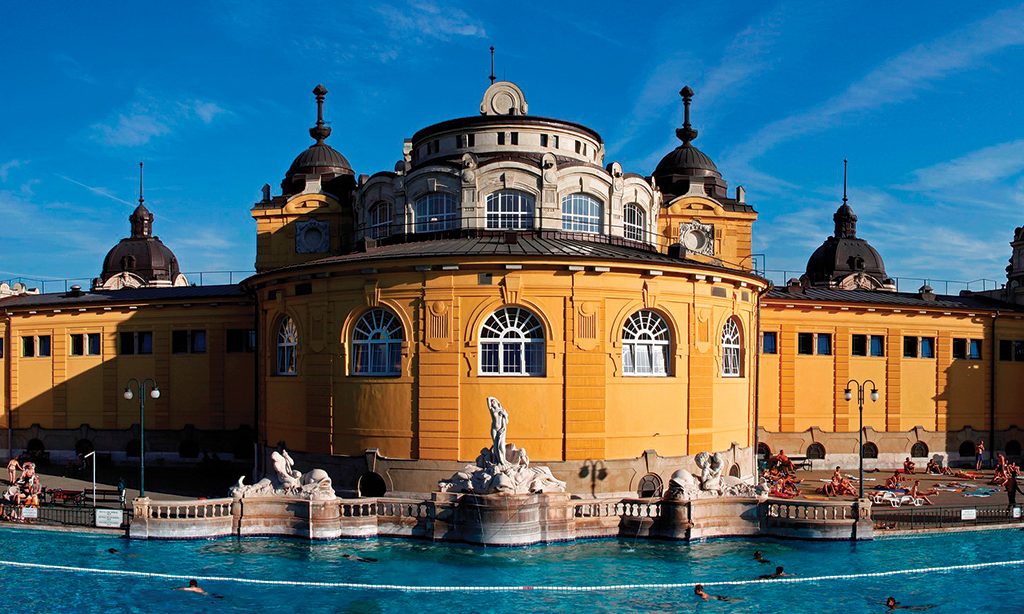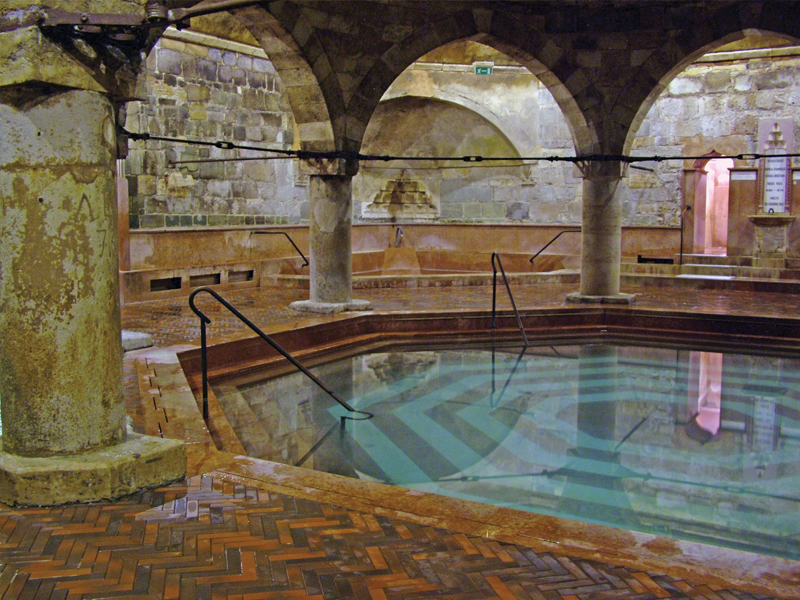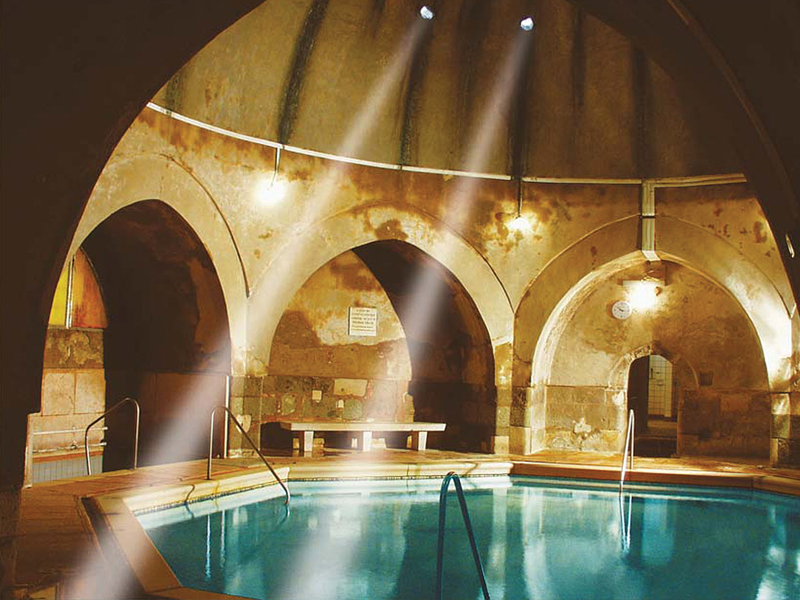Recognised as a “Spa City” since the 1930s, Budapest is the only capital city in our network that is also a spa centre; for centuries, a fashionable place for the celebrities of the day. Even in Roman times, with 14 private and public bath houses, it was a centre rivalled only by Rome itself in terms of bathing facilities.
Today, baths, lidos, beaches and spa hotels use the plentiful thermal waters, which flow at a rate of 70 million litres per day from 123 natural hot springs and bore holes at temperatures ranging from 21ºC to 78 ºC, all with different properties and therapeutic benefits. Visitors shouldn’t miss iconic facilities like the world famous Gellért baths, the Szèchenyi baths, the Rudas and Király baths (both authentic Turkish ones) or the Palatinus Baths.

Budapest Spas cPlc.
Historical Background
Budapest history follows the evolution of two thousand years of bathing culture. Various archeological digs have revealed the traces of settlements on the lands of Pannonia Aquincum and at the camping ground of the II Roman legion. The first, earliest period of the thermal culture may be put at that time, when the first baths had been constructed here. The earliest Hungarian written documents from 1178 mention the existence of a settlement known as Upper Hévíz at the spot of present-day Old Buda (namely Lukács and Császár Bath).
The second significant period came with the Turkish occupation (1541-1686). Many municipal buildings were erected over the springs of medicinal waters; the bath of Aga, called the Muddy bath, at the place of present Gellert Bath, Kücsük ilidzsaszit at the place of present Rác Bath and the Direkli ilidzsaszit at the place of present Rudas Bath. Some of the baths and hamans from that time are still in use today.
The third period falls into the first half of the 1700’s, the age of Enlightenment, when the first studies were completed about the benefits of the hot springs of Buda. In 1762, under the reign of Maria Theresa, it was decreed that mineral waters should “be analyzed and registered at the expense of the Treasury”.
At the beginning of the 1930’s, the world recognized Budapest as the place with the greatest greatest number of healing thermal spring waters, granting the capital with the title of “Spa City”,
In 1937, at the instigation of the Budapest Spa City Society, the first International Congress of Balneology took place here.
Budapest Thermal Baths

Széchenyi Thermal Bath
The Széchenyi Thermal Bath is one of the largest spa complexes in Europe. It’s also the first thermal bath of Pest, built in 1913. It owes its existence to Vilmos Zsigmondy, a mining engineer. On his initiative, some successful deep borings were performed in the City Park, where later, in 1881 already an Artesian bath operated.
The baths are supplied by the Saint Stephen Well Nr.II, whose water are rich in calcium, magnesium, hydro-carbonates, also containing sodium and sulphate and with a significant content in fluoride and metaboric acid. They are mainly used to treat arthritis and other locomotor disorders, as well and in rehabilitation thraumathology treatments.
The complex is also house to a famous buvette, flowing water rich in calcium, magnesium, hydro-carbonate, chloride, sulphate, also containing alcalics and a substantial amount of fluoride. Drinking cures here are indicated for gastric and metabolism disorders as well as a remedy for certain gall-bladder ailments.
Healthcare Services
- Day-time hospital
- Drinking Diets
- Thermal baths
- Steam baths
- Underwater water jet massage
- Underwater currents
- Mud wraps
- Therapheutic Massages
- Foot Massages
- Therapeutic Exercise
- Sauna
Wellness & Leisure
- Fittness Centre
- Aqua Fitness
- Fat-burning Workout
- Cellulite Treatment
- Harmony aroma treatments
- Thai Massages
- Thermal / Aroma massages
- Pedicures
- Swimming Lessons
- Adventure Pool
- Sundeck
- Catering Services

Gellért Thermal Bath
Perhaps the most famous in Budapest, with its iconic Art Nouveau hotel, the imposing Gellért Thermal Bath was built in 1918. Further facilites and expansion were built in the following years, including the wave pool and the efervescent bath. The first records for the “miraculous” springs can be traced back to the 15th century, and in the 18th it was known as Sárosfürdő (“Mud bath”) because of the abundant fine silt depositted at the bottom of the pools harnessing the springs.
Gellért hot mineral waters contain calcium, magnesium and hydrogen-carbonate as well as sulphate-chloride, also containing sodium and with a significant content of fluoride ions. They are indicated for rheumatic diseases, including hernias and athritis as well as neuralgias, vasoconstriction, circulatory conditions, Inhalation are also used to treat respiratory problems.
Healthcare Services
- Day-time hospital
- Medical consultation
- Carbonated baths
- Underwater currents
- Thermal baths
- Electrotherapy
- Inhalations
- Dental Care
- Steam baths
- Underwater water jet massage
- Foot Bath
- Mud wraps
- Royal thermal massage
- Thermal Jacuzzi
- Sauna
- Whirlpools
Wellness & Leisure
- Thermal Massages
- Aroma Massages
- Thai Massages
- Wave Pool
- Sunbeds
- Catering Services

Rudas Thermal Bath
As outstanding example of Turkish Baths dating back to the 16th centuy, when the town was occupied by the Ottoman Empire. Is it recognised by the great dome, 10m diameter, sustained by 8 pillars cover the octogonal pool.
In the late 19th century (1896) a therapeutic swimming facility and a sauna were added. In its drinking hall, the water of the springs Hungária, Attila and Juventus can be consumed for the purposes of a drinking cure.
The components of slightly radioactive thermal water includes sulfate, calcium, magnesium, bicarbonate and a significant amount of fluoride ion. Medical indications of the water is degenerative joint illnesses, chronic and sub-acute joint inflammations, vertebral disk problems, neuralgia and lack of calcium in the bone system.
Healthcare Services
- Thermal Baths
- Thermal Jacuzzi
- Underwater waterjet massage
- Drink Diets
- Swimming Pool
- Steam baths
- Foot Bath
- Therapheutic Massages
- Sauna

Lukács Thermal Bath
In the 12th century, knights of the order of Saint John engaging in curing the sick settled in the area of today’s Lukács Bath, followed by the orders of Rhodos and Malta, who built their monastery baths as well. After the Turkish occupation, the bath became the property of the Treasury. In 1884, Fülöp Palotay purchased the bath from the Treasury, thus a series of transformations began. The spa hotel was built, an up-to-date hydrotherapy department was established and the swimming pool was transformed. People wishing to be healed came from all over the world. The drinking cure hall of the Bath was built in 1937. The first department to ensure complex thermal bath facilities (daytime hospital) was established in 1979 in Budapest, in the Lukács Thermal Bath.
Hot spring water with calcium, magnesium, hydrogen-carbonate and sulphate, chloride, also containing sodium and with a substantial content of fluoride ions. Therapeutic suggestions: degenerative joint diseases, chronic and sub-acute arthritis, spinal deformity, discus hernia, neuralgia, post-accident rehabilitation, Spa treatments, services
Healthcare Services
- Thermal Baths
- Carbonated Baths
- Underwater Currents
- Underwater Waterjet Massage
- Drink Diets
- Mud Wraps
- Salt Chamber Treatment
- Therapheutic Massages
- Foot Massage
- Steam baths
- Sauna and Infrasauna
- Therapeutic Exercis
Wellness & Leisure
- Aqua Fitness
- Solarium
- Sundeck

Király Thermal Bath
To guarante that the inhabitants of Buda would be able to keep attending the Turkish bath in the case of an eventual siege, Pasha Arslan ordered the construction of Kiraly Baths in 1565 within the wall of the fortress, far from the springs. The baths were, and remain the same today, supplied from the sames in Lukács, connected directly to them.
Király Bath is the oldest one in Budapest, along with Rudas bath. The dim light that filters through the tiny holes in the dome covering the octogonal pools gives the places a fascinating atmosphere.
Healthcare Services
- Thermal baths
- Thermal Jacuzzi
- Underwater water jet massage
- Therapheutic Massages
- Steam Bath
- Sauna
- Pedicure
- Foot Massage
Budapest thermal waters are perfectly suitable for the manufacturing of various cosmetics. A specific skincare line branded Omorovicza is available at Gellert Baths, maded with the water from these springs.
Budapest thermal waters are perfectly suitable for the manufacturing of various cosmetics. A specific skincare line branded Omorovicza is available at Gellert Baths, maded with the water from these springs.
Main Springs
Juventus, Attila, Jungaria, Gül Baba, Szent István
Earliest known use
Roman
Hottest Spring
78ºC
Chemical Elements
Calcium, magnesium, hydro-carbonate, sodium, sulphate, fluoride,metaboric acid.

